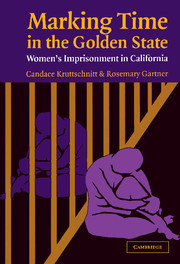Book contents
- Frontmatter
- Contents
- List of Figures and Tables
- Acknowledgments
- Marking Time in the Golden State
- 1 Introduction
- 2 Women, Crime, and Punishment in California
- 3 Entering the Prisons: Methods
- 4 Women's Experiences of Imprisonment at the California Institution for Women in the 1960s and the 1990s
- 5 Variations across Time and Place in Women's Prison Experiences
- 6 Negotiating Prison Life: How Women “Did Time” in the Punitive Era of the 1990s
- 7 Conclusion: The Spectrum of Women Prisoners' Experiences
- Appendix: Characteristics of Interviewees
- References
- Author Index
- Subject Index
2 - Women, Crime, and Punishment in California
Published online by Cambridge University Press: 15 December 2009
- Frontmatter
- Contents
- List of Figures and Tables
- Acknowledgments
- Marking Time in the Golden State
- 1 Introduction
- 2 Women, Crime, and Punishment in California
- 3 Entering the Prisons: Methods
- 4 Women's Experiences of Imprisonment at the California Institution for Women in the 1960s and the 1990s
- 5 Variations across Time and Place in Women's Prison Experiences
- 6 Negotiating Prison Life: How Women “Did Time” in the Punitive Era of the 1990s
- 7 Conclusion: The Spectrum of Women Prisoners' Experiences
- Appendix: Characteristics of Interviewees
- References
- Author Index
- Subject Index
Summary
the post–world war II period was a time of reform and innovation in the California criminal justice system. Optimism about the system's ability to remold offenders through novel rehabilitative programs and therapeutic regimens was widespread, encouraged by the state's booming economy and its self-image as “America's laboratory for social change” (Cross 1968: 110). Through the 1960s and into the 1970s that optimism was sustained even in the face of rising crime rates, social unrest, and an economic slowdown. But by the late 1970s, California had embarked on a series of legislative initiatives that marked the beginning of an “era of hyper-incarceration” (Simon 2000) in the state. These initiatives gained momentum over the next fifteen years as public faith in the government's ability to deal with social problems declined, the disparity between rich and poor expanded, and the state's population grew increasingly more diverse ethnically and racially.
In this chapter we consider how these political, economic, and social changes shaped women's crimes and criminal punishment in California. We describe how female criminals, traditionally seen as less culpable and more redeemable than their male counterparts, were caught up in the state's expanding crime control complex. To do this, we first provide an overview of trends both in criminal justice policies and in public attitudes toward crime and criminals in California during the last four decades of the twentieth century; and we consider the larger demographic, economic, and social context within which these trends occurred.
- Type
- Chapter
- Information
- Marking Time in the Golden StateWomen's Imprisonment in California, pp. 8 - 38Publisher: Cambridge University PressPrint publication year: 2004



